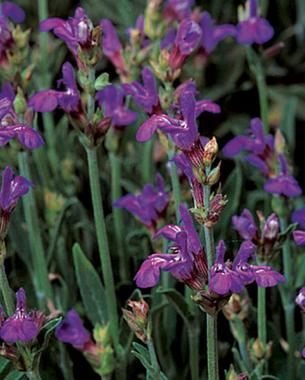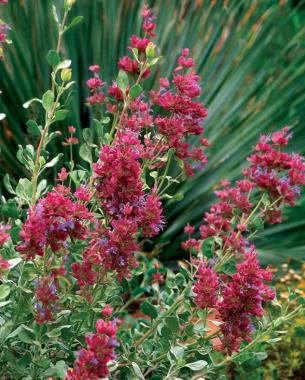Without question, the genus Salvia offers gardeners one of the largest and most versatile groups of perennials. Commonly known as sages, salvias have been embraced for their herbal and medicinal qualities since ancient times, and their usage has expanded over the years due to their ornamental virtues. Salvias deliver an amazing range of forms, textured foliage, and brightly colored flower spikes throughout summer. They combine well with pretty much anything. Many selections attract hummingbirds and butterflies and produce fragrant leaves. Match this with their easygoing, problem-free dispositions and it’s no wonder why they’re among the most popular garden plants around.
Salvias can be found growing in a multitude of habitats, from sea level to tropical cloud forests to subalpine mountain slopes, which is why they’re so adaptable to almost any garden condition except deep shade and excessive moisture. Many salvias are xeric or waterwise, which means they’re well suited for dry conditions. Rabbits, deer, and other leaf-eating mammals don’t bother with these gems. There’s also no need to worry about insect pests or diseases; these plants are just not prone to them.
Salvias are essentially the perfect garden plants. Indeed, the list of gardenworthy salvias is a long one. Here is a sampling of some of my favorite perennial players to get your mouth watering.
Short: Less than 18 inches tall

Dwarf common sage
NAME: Salvia officinalis ‘Minimus’
USDA HARDINESS ZONES: 5 to 9
HEIGHT: 15 to 18 inches
Dwarf common sage is a tightly compact form of the culinary common sage (S. officinalis), which is notable for its narrow, fragrant, gray-green leaves and lavender-blue, white-lined flowers in late spring or early summer. I have found this variety to be extremely xeric and well behaved. It doesn’t produce seed and become weedy like common sage. The two nonflowering cultivars, ‘Icterina’, with its variegated green-and-chartreuse foliage, and ‘Purpurascens’, with its purple-hued leaves, are fantastic additions to beds and containers; both are hardy in Zones 6 to 10.

Photo/Illustration: Courtesy of High Country Gardens
Yugoslavian cutleaf sage
NAME: Salvia jurisicii
ZONES: 5 to 9
HEIGHT: 18 inches
Yugoslavian cutleaf sage is an eye-catching plant in and out of bloom, with its attractive basal rosette of feathery foliage and showy display of dense flower spikes. If you look closely at the flowers, you’ll notice that they are held upside down on the spike. The flowers come in shades of blue, white, and light pink, but the dark blue strain (S. jurisicii ‘Blue’) is the most desirable. Best planted in enriched garden loam, Yugoslavian cutleaf sage blooms in late spring. It combines beautifully at the front of the border with the soft pink flowers of fragrant Persian stonecress (Aethionema schistosum, Zones 4–8), which open in mid- to late spring.

Germander sage
NAME: Salvia chamaedryoides
ZONES: 7 to 11
HEIGHT: 18 inches
Germander sage is a delightful Mexican species grown for its striking gray foliage and profusion of true blue flowers in early summer and fall. This plant spreads vigorously by underground stems. Full sun and well-drained soils are a must for this heat-loving plant.

‘May Night’ meadow sage
NAME: Salvia X sylvestris ‘May Night’, syn. ‘Mainacht’
ZONES: 4 to 9
HEIGHT: 18 inches
‘May Night’ meadow sage was first released in 1956 and has maintained its strong popularity ever since. Blooming with dark indigo-blue spikes beginning in late spring, this stellar perennial is an unfailing performer in all types of soils, including difficult clay. When promptly deadheaded, it reblooms periodically throughout the summer. ‘Blue Hill’, a clear blue–flowered cultivar, is another top-notch choice that is similar to ‘May Night’ in its ease of cultivation.

Desert purple sage
NAME: Salvia dorrii
ZONES: 5 to 9
HEIGHT: 18 inches
Found in the Great Basin deserts of the western United States, desert purple sage is by far one of our most beautiful native salvia species. A small, woody shrub, it comes into bloom in late spring with short spikes of showy purple bracts and blue flowers. The semievergreen foliage is distinctively silvery gray and highly aromatic. Planting desert purple sage in fast-draining, infertile, alkaline soil and full sun is important to long-term success. Consider partnering it with pineleaf beardtongue (Penstemon pinifolius, Zones 4–10), which prefers similar conditions and displays hundreds of bright orange flowers in late spring.
Sage
Salvia spp. and cvs.
(SAL-vee-ah)
Origin
Members of the genus Salvia are found on every continent except Australia and Antarctica. They are commonly called “salvias” as a group; individual plants are often referred to as “sage.” There are more than 900 annual, biennial, and perennial species, which can be either herbaceous or woody in habit. Species readily hybridize; there are many named cultivars and hybrids.
Conditions
Salvias vary in hardiness based upon individual species, ranging from USDA Hardiness Zones 3 to 11. They generally grow in full sun to partial shade and are adaptable to any well-draining soil.
Pests and Diseases
Healthy plants of this genus are rarely troubled by pests and diseases. One might occasionally spot an aphid on fresh spring flower spikes or spider mites on drought-stressed foliage. Tender varieties can suffer whiteflies, especially when brought indoors.
Care
Salvias require minimal fertilization. Top-dress plants with an organic fertilizer and compost mixture in fall. Deadheading flowers will encourage more blooms. Pruning should be done in spring, except for S. dorrii and S. pachyphylla, which should be lightly pruned after flowering. In cooler climates, tender salvias can easily be overwintered as potted plants in a warm, bright location.
Propagation
Salvias are readily propagated by softwood cuttings or division. Cuttings can be taken at any time from newer growth. The best time to divide is in early spring, although plants can be transplanted almost any time during the growing season.
Medium: 18 to 36 inches tall

Photo/Illustration: Bill Johnson
‘Maraschino’ bush sage
NAME: Salvia ‘Maraschino’
ZONES: 6 to 10
HEIGHT: 36 inches
‘Maraschino’ bush sage is another superb salvia that is irresistible to hummingbirds and gardeners alike. After dying back to the ground each winter in my Zone 6 climate, this plant comes back in full force each spring, reaching its full height and covering itself with cherry red blooms by midsummer. The flowers go nonstop through the first hard frost, and the leaves are sweetly fragrant. Plants do best when given afternoon shade. For gardeners who would like a touch of red a little farther north, consider the closely related variety ‘Furman’s Red’ autumn sage (S. greggii ‘Furman’s Red’, Zones 5–10), which grows about a foot shorter but produces striking red flowers most heavily in late spring and early fall.

Pitcher sage
NAME: Salvia azurea
ZONES: 5 to 9
HEIGHT: 30 to 36 inches
Pitcher sage is a wonderful wildflower found growing over a wide area of the Great Plains. Blooming in late summer and early fall, this perennial is admired for its sky blue flowers and remarkable xeric qualities. Pinch the lax stems once or twice in early summer to encourage sturdier growth that will support the blooms. Plants will grow in most well-drained soils, but you should avoid clay. ‘September Snow’ is an ornamental white-flowering cultivar that is worth hunting for.

‘Purple Rain’ sage
NAME: Salvia verticillata ‘Purple Rain’
ZONES: 5 to 8
HEIGHT: 24 inches
‘Purple Rain’ sage is a wonderful cultivar of a European native. It brings a sensual, smoky purple color to the perennial border with its substantial flower spikes. The blooms continue throughout the summer and make excellent cut flowers that mingle nicely with the rosy red flowers of ‘Coccineus’ Jupiter’s beard (Centranthus ruber ‘Coccineus’, Zones 5–8). Performing best in well-drained, compost-enriched soil, ‘Purple Rain’ benefits from regular irrigation during summer dry spells. In hotter climates, plant it in afternoon shade with a layer of mulch to keep its soil more evenly moist.

Giant-flowered purple sage
NAME: Salvia pachyphylla
ZONES: 5 to 9
HEIGHT: 24 to 36 inches
Giant-flowered purple sage has been winning over gardeners the past few years for its remarkable summer blooms and tough-as-nails demeanor. Native to the dry foothills and mountains of southern California, this sage is considered a woody shrub. It features showy, aromatic silver foliage and bicolored flower spikes with lavender-purple calyces (small petal- or leaflike structures that surround the base of the flower) and long, hummingbird-pollinated blue flowers. Plant giant-flowered purple sage where it will get full sun in well-drained, infertile, alkaline soil.
Tall: More than 36 inches tall

‘Limelight’ Mexican sage
NAME: Salvia mexicana ‘Limelight’
ZONES: 8 to 11
HEIGHT: 60 inches tall
‘Limelight’ Mexican sage is a unique salvia. The first time I saw it, I knew I had to have it. The original plant was collected in southern Mexico and aptly named ‘Limelight’ for its chartreuse-green calyces and vibrant violet-blue flowers in late fall. Unfortunately for northern gardeners, ‘Limelight’ is best grown in warmer regions, even if you choose to treat it like an annual. With its late-season blooms, this plant’s buds can be zapped by a hard frost in colder areas before the flowers even open. Many gardeners, however, don’t mind taking a chance and choose to grow ‘Limelight’ beyond its recommended boundaries. For healthy growth with lots of blooms, provide compost-enriched soil and regular irrigation, and pinch the stem tips early in the season.

‘Indigo Spires’ sage
NAME: Salvia ‘Indigo Spires’
ZONES: 7 to 11
HEIGHT: 48 inches
‘Indigo Spires’ sage is a vigorous hybrid that was discovered at the Huntington Botanical Gardens in 1979. Prized for its 12- to 15-inch-long, twisting spikes of dark violet flowers, this showstopper is a nonstop bloomer from early summer through fall. Blooming can be further encouraged by pinching stem tips early in the growing season and deadheading the spikes once they fade. ‘Indigo Spires’ benefits from winter protection when grown in Zone 7. In areas too cold to overwinter the plant in the ground, consider placing this tender perennial in a large container, which can be moved to a protected location when temperatures drop. Try pairing ‘Indigo Spires’ with the airy pink or white blooms of whirling butterflies (Gaura lindheimeri and cvs., Zones 6–9) for a frenzy of flowers in the heat of summer.

West Texas cobalt sage
NAME: Salvia reptans
ZONES: 5 to 10
HEIGHT: 48 inches
West Texas cobalt sage is another marvelously distinct species that can be enjoyed by gardeners farther north as long as they purchase the west Texas form, which is quite cold hardy. Discovered in the cold, dry Davis Mountains of west Texas, this salvia has rigid stems with narrow, pungent leaves and resembles a bright green, upright grass for much of the growing season. In early fall, cobalt blue flowers burst open almost overnight and are a big draw for hummingbirds. Thanks to its deep roots, this wildflower is extremely xeric. West Texas cobalt sage thrives in well-drained, alkaline soils. Plant it near hardy hummingbird trumpet (Zauschneria arizonica, Zones 5–9), with its red-orange fall blooms, for a striking combination and hummingbird extravaganza. As with the rest of the members of this wonderfully diverse and reliable genus, west Texas cobalt sage is an undemanding beauty that can easily be worked into almost any garden scheme.

Mexican bush sage
NAME: Salvia leucantha
ZONES: 8 to 10
HEIGHT: 48 inches
Mexican bush sage is an exceedingly popular herbaceous species grown throughout the southern United States. Its vigor and large mature size make it a good choice for landscape use. Its individual fuzzy white flowers project from purple calyces, giving the flowering spikes a nice bicolored effect in early fall. There are several notable cultivars of Mexican bush sage that are worth seeking out. ‘Midnight’ is a dark-flowered selection with purple flowers and calyces. ‘Santa Barbara’ is a tidy, smaller cultivar that produces a compact mound only 30 inches tall and 48 inches wide. All forms are easily grown in any well-drained soil. This species has been known to be hardy in the warmer parts of Zone 7.

















Comments
Log in or create an account to post a comment.
Sign up Log in